
Gudja is a village in the Southern Region of Malta, with a population of 3,148 as of March 2017. The village is located on high grounds, south of Valletta. It is administered by the Gudja Local Council. A number of schools, clubs, public gardens and recreations places are found around the village. The Malta International Airport is also located in Gudja.
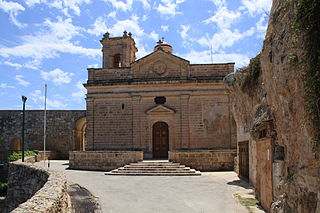
The Sanctuary of Our Lady of Mellieħa is a Roman Catholic church in the village of Mellieħa in Malta. The sanctuary originated as a natural cave which was consecrated as a church at an unknown date, and local traditions link its establishment to antiquity or the medieval period. The church's altarpiece is a Byzantine-style fresco which is believed to date back to the late 12th or early 13th centuries, and it is said to be miraculous.
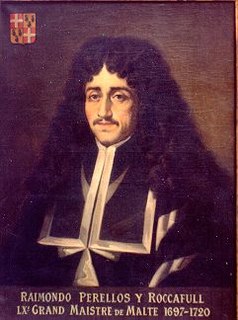
Ramon Perellós i Rocafull was a Spanish knight of Aragon who served as the 64th Prince and Grand Master of the Order of Malta from 1697 until his death. He was of Valencian origin and was 60 years old when he was elected as Grand Master.

The Grandmaster's Palace, officially known as The Palace, is a palace in Valletta, Malta. It was built between the 16th and 18th centuries as the palace of the Grand Master of the Order of St. John, who ruled Malta, and was also known as the Magisterial Palace. It eventually became the Governor's Palace, and it currently houses the Office of the President of Malta. Parts of the building, namely the Palace State Rooms and the Palace Armoury, are open to the public as a museum run by Heritage Malta.

The Our Lady of Victory Church, formerly known as the Saint Anthony the Abbot Church, was the first church and building completed in Valletta, Malta. In 1566, following the Great Siege of Malta, Grand Master Jean Parisot de Valette and his Order showed interest to build a church in the name of the Nativity of the Virgin as a form of thanksgiving; the construction was funded by De Valette.
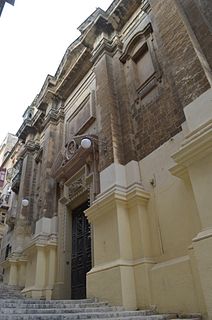
The Franciscan Church of St Mary of Jesus is a church in Valletta, Malta, which is dedicated to St Mary of Jesus and is cared for by the religious order of Friars Minor. It came to be popularly known by the Maltese as Ta' Ġieżu. Ta' Ġieżu is a local corruption of Ta' Ġesù.

The Auberge d'Italie is an auberge in Valletta, Malta. It was built at various stages in the late 16th century to house knights of the Order of Saint John from the langue of Italy, and it originally had a Mannerist design by Girolamo Cassar and several other architects. The building continued to be modified throughout the course of the 17th century, with the last major renovation being carried out in the 1680s during the magistracy of Gregorio Carafa, giving the building a Baroque character.

The Nibbia Chapel was a Roman Catholic chapel in Valletta, Malta, which was dedicated to Our Lady of Mercy. It was originally built in 1619 by Fra Giorgio Nibbia, a knight of the Order of St. John, and it was located near a cemetery where deceased patients from the nearby Sacra Infermeria were buried.

The Church of St James is a Roman Catholic church in Valletta, Malta. A previous Mannerist church was built on site in the early 17th-century and demolished in the early 18th-century to built the present baroque church. Built on the designs of Romano Carrapecchia, the church served for religious service to the Langue of Castille. It remain an active church, found in Merchants Street, and it is a scheduled cultural building in a World Heritage Site. The church has a number of artistic features, including its imposing façade and paintings, one drawn by Filippo Paladini and another dating back than the present church itself. Nowadays the church is also used for services by the Ethiopian Orthodox Tewahedo Church and the Eritrean Orthodox Tewahedo Church.

The Basilica of Our Lady of Mount Carmel is a Roman Catholic church in the capital Valletta on the island of Malta. It is one of the most famous churches and main tourist attractions of Valletta, and it forms part of a UNESCO World Heritage site which includes the entire city.

The Church of St Barbara is a Roman Catholic church situated in Valletta, Malta. The church was built to service the spiritual needs of the knights of Provence.

The Church of Our Lady of Liesse is a church in Valletta, Malta. The church was built in 1740 on the site of a 17th-century church. The copula was built to the designs of the Maltese Architect Francesco Zammit. The church is located near the shores of the Grand Harbour, close to Lascaris Battery and the site of the fish market. It is especially venerated by the people of the port area.
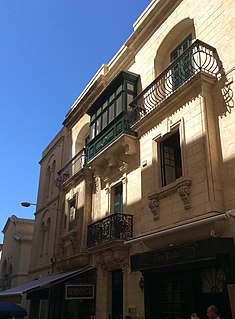
The Malta Postal Museum is a postal museum in Valletta, Malta. It is run by the postal operator MaltaPost, and it was inaugurated on 17 June 2016. The museum is housed in a restored 20th-century townhouse in the centre of Valletta, close to the Grandmaster's Palace and the Church of Our Lady of Damascus.

Admiralty House, formerly known as Casa Miari, Palazzo Don Raimondo and by several other names, is a palace in Valletta, Malta. It was originally built in 1569–70 as two private houses by Fra Jean de Soubiran dit Arafat, a knight of the Order of St. John. The houses were later leased to various owners, including Fra Raimondo de Sousa y Silva, who rebuilt them a single residence between 1761 and 1763.
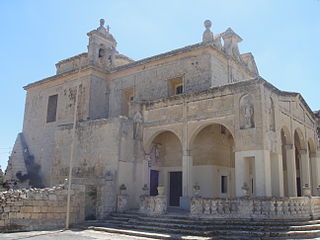
The Shrine of Our Lady of Mercy also known as Chiesa Della Misericordia or simply known as Tal-Ħniena is a Roman Catholic church located i the village of Qrendi, Malta. The church is referred to as a sanctuary due to people's devotion to the Virgin Mary of Mercy.

The Parish Church and Sanctuary of Our Lady of Graces is a Roman Catholic parish church in Żabbar, Malta, dedicated to Our Lady of Graces. The church was originally built between 1641 and 1696 to designs of the Renaissance architect Tommaso Dingli. Its façade, an outstanding example of Maltese Baroque architecture, was built in 1738 to designs of Giovanni Bonavia. The dome was rebuilt in the early 19th century after it had been damaged during the French blockade of 1798–1800, and it was rebuilt again in the first half of the 20th century to designs of Giuseppe Pace.

The Church of Our Lady of Sorrows is a Roman Catholic church in Pietà, Malta. It was established in the late 16th or early 17th century near a cemetery in which victims of the 1592–1593 Malta plague epidemic were buried. It was originally dedicated to Saint Roch, but after a convent was built next to it in the early 17th century it was rededicated to Our Lady of Sorrows. The church later gave its name to the town of Pietà which developed nearby, and the present building dates back to the mid-18th century when it was reconstructed. Both the church and the convent are currently in the hands of a Catholic youth ministry.
Romano Fortunato Carapecchia (1666–1738) was an Italian Baroque architect who was active in Rome, Malta and Sicily. His designs helped transform Malta's capital Valletta into a Baroque city in the first few decades of the 18th century.

The Chapel of St Nicholas is a Roman Catholic chapel located in Fort Ricasoli in Kalkara, Malta. It was built between 1696 and 1698 as a parish church for the fort's garrison, and it was dedicated to Saint Nicholas of Bari. The chapel remained in use until the fort was decommissioned in the 1960s, and it fell into a state of disrepair. Currently there are plans to restore the chapel along with the rest of the fort.

St Catherine's Monastery is a monastery in Valletta, Malta which houses cloistered nuns of the Second Order of Saint Augustine. It incorporates the Church of the Presentation of Our Lady, which is more commonly known as the Church of St Catherine. The church and monastery were built in the 18th century and they replaced a previous monastery which had been housed in a 16th-century palace.





















